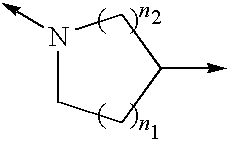Method for treating pulmonary diseases using rho kinase inhibitor compounds
a technology of kinase inhibitors and compounds, applied in the direction of heterocyclic compound active ingredients, drug compositions, biocides, etc., can solve the problems of reducing the elastic recoil and hyperinflation of the lung, limiting the airflow, and reducing the integrity of the lung connective tissu
- Summary
- Abstract
- Description
- Claims
- Application Information
AI Technical Summary
Benefits of technology
Problems solved by technology
Method used
Image
Examples
example 1
Relevance:
[0269]This assay demonstrates a compound's ability to inhibit ROCK2 and ROCK1 in an in vitro setting using the isolated enzyme. Compounds having ROCK2 IC50 values on the order of 2 μM or below have been shown to possess efficacy in many studies using in vivo models of the disease processes described in this application.
Protocol
[0270]Inhibition of ROCK2 and ROCK1 activity was determined using the IMAP™ Screening Express Kit (Molecular Devices product number #8073). ROCK2 enzyme (Upstate / Chemicon #14-451), ROCK1 (Upstate / Chemicon #14-601) and Flourescein tagged substrate peptide Fl-AKRRRLSSLRA (Molecular Devices product number R7184) was pre-incubated with a test compound (a Formula I or II compound or other rho kinase compound such as fasudil, H-1152, H7, Y-27632, Y-39983) for 5 minutes in buffer containing 10 mM Tris-HCl pH 7.2, 10 mM MgCl2, and 0.1% BSA. Following the pre-incubation, 10 μM ATP was added to initiate the reaction. After 60 minutes...
example 2
NIH / 3T3 Cell Morphology Assay
Relevance
[0273]The assay demonstrates that a compound's in vitro ROCK inhibition activity manifests itself in morphology changes, such as actin stress fiber disassembly and alteration in focal adhesions in intact cells leading to inhibition of acto-myosin driven cellular contraction. These morphology changes provide the basis for the beneficial pharmacological effects sought in the setting of the disease processes described in this application, specifically the disruption of the actin stress fibers and its impact on smooth muscle contractility; cell mobility (Howard et. al. The J. of Cell Biology 98:1265-1271, 1984); and endothelial and epithelial permeability (Stephens et al., Am. Rev. Respir. Dis. 137:4220-5, 1988 and Vandenbroucke et al., Ann. N.Y. Acad. Sci. 1123: 134-145, 2008.)
Protocol
[0274]NIH / 3T3 cells were grown in DMEM-H containing glutamine and 10% Colorado Calf Serum. Cells were passaged regularly prior to reaching confluence. Eighteen to 24 ...
example 3
Tracheal Relaxation Assay
Relevance
[0276]The mechanism by which bronchoconstricting agents induce smooth muscle contraction is known to involve the activation of Rho kinase (Yoshii et al, Am J Respir Cell Mol Biol 20:1190-1200 (1999)). These data demonstrate that inhibition of Rho pathways with the described compounds induces relaxation of smooth muscle. Since diseases accompanied by airway hyperreactivity and / or bronchoconstriction, such as asthma, COPD, RSV infection, LAM and IPF, involve a contraction of airway smooth muscle, agents that induce a relaxant response in the tracheal smooth muscle can be candidates for treatment of such diseases. Standard clinical treatments for respiratory disorders involving airway hyperreactivity and / or bronchoconstriction, such as albuterol, formoterol and salmeterol, have been shown to demonstrate relaxant properties in tracheal smooth muscle (Battram et al, J Pharmacol Exp Therap 317:762-770 (2006)). Therefore, the activity of the present compou...
PUM
| Property | Measurement | Unit |
|---|---|---|
| Volume | aaaaa | aaaaa |
| Volume | aaaaa | aaaaa |
| Molar density | aaaaa | aaaaa |
Abstract
Description
Claims
Application Information
 Login to View More
Login to View More - R&D
- Intellectual Property
- Life Sciences
- Materials
- Tech Scout
- Unparalleled Data Quality
- Higher Quality Content
- 60% Fewer Hallucinations
Browse by: Latest US Patents, China's latest patents, Technical Efficacy Thesaurus, Application Domain, Technology Topic, Popular Technical Reports.
© 2025 PatSnap. All rights reserved.Legal|Privacy policy|Modern Slavery Act Transparency Statement|Sitemap|About US| Contact US: help@patsnap.com



